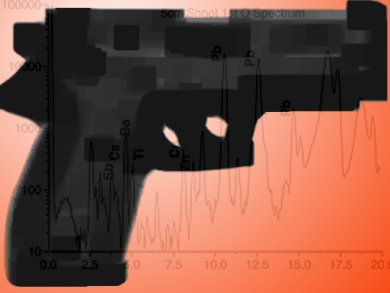X-ray techniques are widely used by forensic laboratories, e.g., for the analysis of fibres, hair, glass and paint specimens. Advantages of the technique are its low cost, non-destructive nature, ease of operation and interpretation.
Melanie Bailey, University of Surrey, Guildford, UK, edited a special issue comprising a collection of articles focusing on how complementary X-ray spectrometry methods may assist the forensic investigations of the future.
For example, Anna Galli, CNR-IFN, CNR – Istituto di Fotonica e Nanotecnologie, Milano, Italy, and colleagues show how portable energy-dispersive X-ray fluorescence (XRF) devices are used in cultural heritage. Forensic and cultural heritage scientific analyses have several similarities. Both deal with unique, ‘precious’ and often quantitatively very limited objects, which have to be preserved as much as possible. The team shows a few peculiar case studies in which scientific examination proved to be helpful in solving historical and archaeological uncertainty.
One of the most important aspects of the criminal investigation of a shooting incident is the target-to-muzzle distance determination. This can establish the relative positions of the shooter and the victim or even help to establish the shooters’ intent. Joao F. Fonseca, Laboratório de Polícia Científica da Polícia Judiciária, Lisbon, and Universidade de Lisboa, Lisbon, both Portugal, and colleagues demonstrate that energy-dispersive XRF can be an alternative for the standard procedure using chemographic tests. Big advantages are that it is fast, non-destructive, and without the need of chemical preparation.
Jun Kawai, Kyoto University, Japan, gives an interesting account of the Jury’s interpretation of the synchrotron XRF (SXRF) data from two experts to analyze a poisoning case by arsenic in 1998 in Japan. By adding his own interpretation to the data, he highlights the complexity of interpretation of XRS spectra in a forensic context. Recent analysis of Fe, Zn, Mo, and Ba in one of the raw spectra measured in 1998 reveals the arsenic stored in the kitchen of the condemned criminal in the death row was significantly different from that of the paper cup used for poisoning.
 Special Issue: X-ray Spectrometry in Forensics,
Special Issue: X-ray Spectrometry in Forensics,
X-Ray Spectrom. 2014, 43 (1).
 Editorial,
Editorial,
Melanie Bailey,
DOI: 10.1002/xrs.2506
 Signal-to-noise ratios in forensic glass analysis by micro X-ray fluorescence spectrometry,
Signal-to-noise ratios in forensic glass analysis by micro X-ray fluorescence spectrometry,
T. Ernst, T. Berman, J. Buscaglia, T. Eckert-Lumsdon, C. Hanlon, K. Olsson, C. Palenik, S. Ryland, T. Trejos, M. Valadez, J. R. Almirall,
DOI: 10.1002/xrs.2437
 True versus forged in the cultural heritage materials: the role of PXRF analysis,
True versus forged in the cultural heritage materials: the role of PXRF analysis,
A. Galli, L. Bonizzoni,
DOI: 10.1002/xrs.2461
 Optimizing FEG-SEM combined with an SDD EDX system for automated GSR analysis,
Optimizing FEG-SEM combined with an SDD EDX system for automated GSR analysis,
Elad S. Izraeli, Tsadok Tsach, Nadav Levin,
DOI: 10.1002/xrs.2495
 Quantitative analysis of heavy elements and semi-quantitative evaluation of heavy mineral compositions of sediments in Japan for construction of a forensic soil database using synchrotron radiation X-ray analyses,
Quantitative analysis of heavy elements and semi-quantitative evaluation of heavy mineral compositions of sediments in Japan for construction of a forensic soil database using synchrotron radiation X-ray analyses,
Izumi Nakai, Shunsuke Furuya, Willy Bong, Yoshinari Abe, Keiichi Osaka, Takuya Matsumoto, Masayoshi Itou, Atsuyuki Ohta, Toshio Ninomiya,
DOI: 10.1002/xrs.2496
 Muzzle-to-target distance determination by X-ray fluorescence spectrometry,
Muzzle-to-target distance determination by X-ray fluorescence spectrometry,
J. F. Fonseca, M. M. Cruz, M. L. Carvalho,
DOI: 10.1002/xrs.2497
 The secondary transfer of gunshot residue: an experimental investigation carried out with SEM-EDX analysis,
The secondary transfer of gunshot residue: an experimental investigation carried out with SEM-EDX analysis,
James French, Ruth Morgan, James Davy,
DOI: 10.1002/xrs.2498


